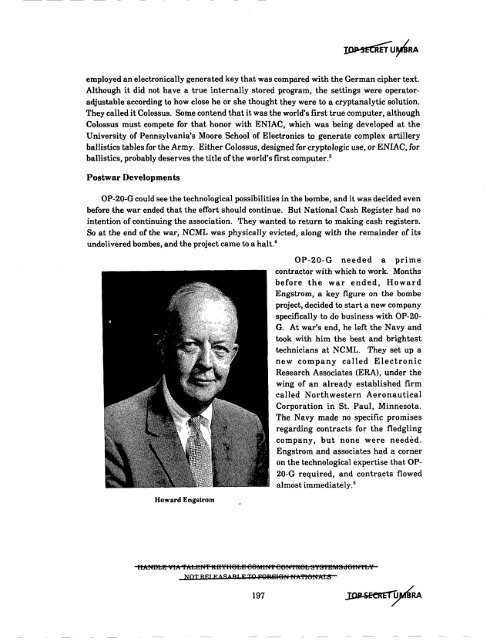American Cryptology during the Cold War - The Black Vault
American Cryptology during the Cold War - The Black Vault
American Cryptology during the Cold War - The Black Vault
You also want an ePaper? Increase the reach of your titles
YUMPU automatically turns print PDFs into web optimized ePapers that Google loves.
employed an electronically generated key that was compared with <strong>the</strong> German cipher text.<br />
Although it did not have a true internally stored program, <strong>the</strong> settings were operatoradjustable<br />
according to how close he or she thought <strong>the</strong>y were to a cryptanalytic solution.<br />
<strong>The</strong>y called it Colossus. Some contend that it was <strong>the</strong> world's first true computer, although<br />
Colossus must compete for that honor with ENIAC, which was being developed at <strong>the</strong><br />
University of Pennsylvania's Moore School of Electronics to generate complex artillery<br />
ballistics tables for <strong>the</strong> Army. Ei<strong>the</strong>r Colossus, designed for cryptologic use, or ENIAC, for<br />
ballistics, probably deserves <strong>the</strong> title of<strong>the</strong> world's first computer. 3<br />
Postwar Developments<br />
OP-20-G could see <strong>the</strong> technological possibilities in <strong>the</strong> bombe, and it was decided even<br />
before <strong>the</strong> war ended that <strong>the</strong> effort should continue. But National Cash Register had no<br />
intention ofcontinuing <strong>the</strong> association. <strong>The</strong>y wanted to return to making cash registers.<br />
So at <strong>the</strong> end of <strong>the</strong> war, NCML was physically evicted, along with <strong>the</strong> remainder of its<br />
undelivered bombes, and <strong>the</strong> project came to a halt.'<br />
Howard Engstrom<br />
OP-20-G needed a prime<br />
contractor with which to work. Months<br />
before <strong>the</strong> war ended, Howard<br />
Engstrom, a key figure on <strong>the</strong> bombe<br />
project, decided to start a new company<br />
specifically to do business with OP-20<br />
G. At war's end, he left <strong>the</strong> Navy and<br />
took with him <strong>the</strong> best and brightest<br />
technicians at NCML. <strong>The</strong>y set up a<br />
new company called Electronic<br />
Research Associates (ERA), under <strong>the</strong><br />
wing of an already established firm<br />
called Northwestern Aeronautical<br />
Corporation in St. Paul, Minnesota.<br />
<strong>The</strong> Navy made no specific promises<br />
regarding contracts for <strong>the</strong> fledgling<br />
company, but none were needed.<br />
Engstrom and associates had a corner<br />
on <strong>the</strong> technological expertise that OP<br />
20-G required, and contracts flowed<br />
almost immediately.s<br />
1I1d'Bbl!l 'iIA 'fAbI!Jli'f IlI!JYIIebI!J eeMIN'f eeN'ffteb SYS'fI!Jf9IS deIN'fbY<br />
NOT REI E AS ABI F 'to i'QRI!JI8H n-A:'f16f4'ALS<br />
197
















